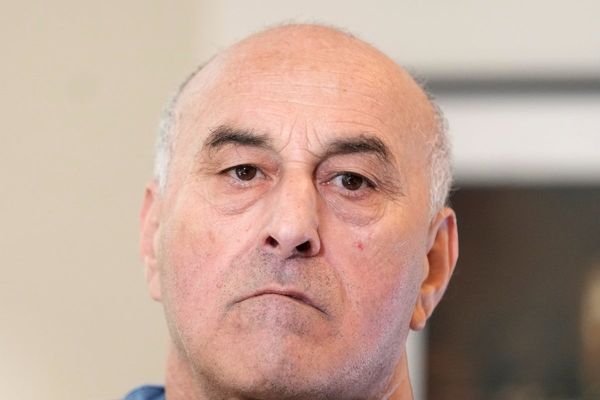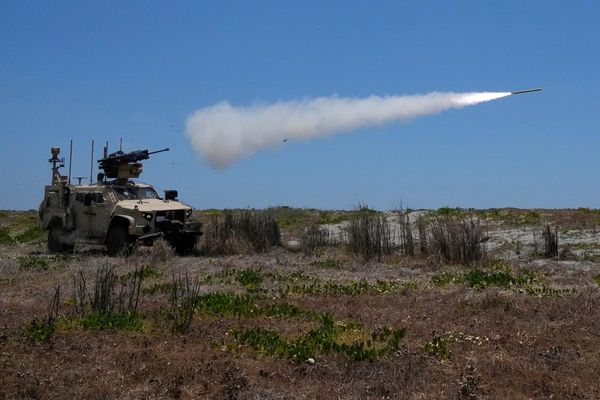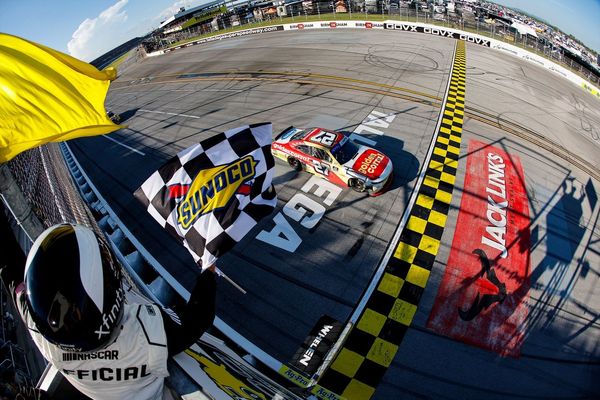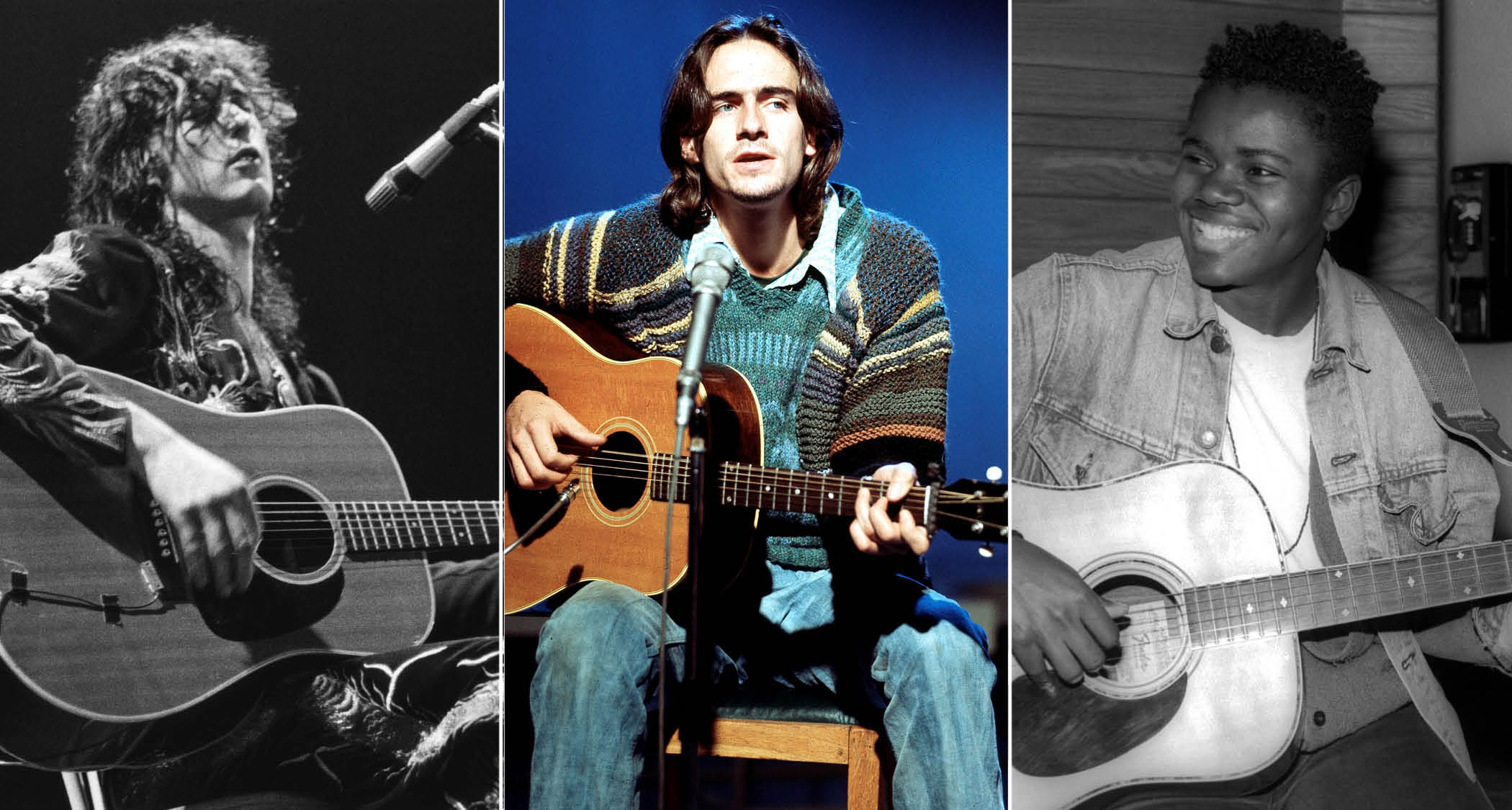
Not too long ago, we posted a poll to find out your views on the greatest acoustic guitar songs of all time. There are, of course, so many to choose from, and our shortlist of 120 landmark tracks covered early blues, folk and rock ’n’ roll classics to modern pop hits and rock epics.
There was just one simple rule for inclusion: in every song, the acoustic guitar should be a significant feature. With a massive 75,000+ public votes cast, here we present a rundown of the greatest acoustic guitar songs as chosen by you.
We start by listing the tracks from number 50 to 21, before going into more depth with the songs that received the most votes…
50 to 21
50. The Entertainer – Chet Atkins
49. Shape Of My Heart – Sting
48. Somebody That I Used To Know – Mike Dawes
47. The River – Bruce Springsteen
46. Cross Road Blues – Robert Johnson
45. 1952 Vincent Black Lightning – Richard Thompson
44. Spanish Fly – Van Halen
43. Just Breathe – Pearl Jam
42. Mediterranean Sundance – Al Di Meola
41. Big Yellow Taxi – Joni Mitchell
40. Iris – Goo Goo Dolls
39. Drifting – Andy McKee
38. Classical Gas – Mason Williams
37. The Clap – Yes
36. Good Riddance (Time Of Your Life) – Green Day
35. Angelina – Tommy Emmanuel
34. Wonderwall – Oasis
33. Crazy Little Thing Called Love – Queen
32. Jolene – Dolly Parton
31. Wanted Dead Or Alive – Bon Jovi
30. Redemption Song – Bob Marley And The Wailers
29. Life By The Drop – Stevie Ray Vaughan
28. Romeo And Juliet – Dire Straits
27. Nutshell – Alice In Chains
26. Carry On – Crosby, Stills, Nash & Young
25. I Walk The Line – Johnny Cash
24. Maggie May – Rod Stewart
23. More Than Words – Extreme
22. Crazy On You – Heart
21. (Sittin’ On) The Dock Of The Bay – Otis Redding
20. Tangled Up In Blue – Bob Dylan
The opening track from Dylan’s classic album Blood On The Tracks was famously powered by two highly collectable acoustic guitars – the 1950s Martin 00-21 in Dylan’s hands and the 1969 Martin D-28 played by guest guitarist Kevin Odegard.
The opening idea sees them strumming between A and Asus4, then moving between A, G and D during the verses and eventually introducing E and F#m shapes for the chorus sections.
It’s the kind of song even beginners wouldn’t take long to feel at ease with – though, as per many of Dylan’s genre-defining masterpieces, it’s simple stuff done very, very well.
19. Patience – Guns N’ Roses (1988)
From a six-string perspective, Patience could be the easiest Guns N’ Roses song of them all. Built around the simple cowboy chords that almost every player starts out with, it’s not so much the shapes that present a challenge as much as it is Izzy Stradlin’s picking pattern.
And though he tends to live in the minor world, on this track Slash’s solo is composed out of the major pentatonic scale, with some additional notes from the major scale for extra colour, which is what gives it that uplifting, breezy feel.
18. Nothing Else Matters – Metallica (1991)
While E minor arpeggios can be found all over the neck, there can be no doubt that the easiest way of playing one would be using the open strings in the same way James Hetfield did for the intro and outro of Nothing Else Matters.
The idea then builds using notes on the 7th, 8th, 5th and 3rd frets of the high E string to spell out the E natural minor scale, moving into arpeggios for chords from the same key like Am6, C and D, before closing the opening segment with some natural harmonics found at the 12th fret. It’s a masterclass in how to captivate your audience from the get-go through a fog of brooding atmospheric sadness.
17. Fast Car – Tracy Chapman (1988)
Chapman’s folk-rock ballad is the song that launched Chapman’s career when it was released as the lead single for her debut album. With just four chords – C, G, Em and D – she enchants the listener with her tale of a working woman’s attempts to escape poverty. She recorded the song on her Martin D-18E with DeArmond pickups, using a capo on the 2nd fret.
The deceptively simple arrangement gets much of its character from the upper register voicings of the Em and D chords, using artful melodic embellishments to add colour. Countless artists have covered the song, assuring the song its enduring legacy.
16. The Needle And The Damage Done – Neil Young (1972)
Neil Young’s instincts to use a live performance in a studio record were sound. Tracked on 30 January 1971 at UCLA’s Royce Hall, in Los Angeles, this ode to heroin and its gruesome, deleterious effect on its users is best shared in concert. The message’s poignancy demands an audience.
Young’s former Crazy Horse guitarist/vocalist Danny Whitten was one of the song’s inspirations. He lost his life to heroin in 1972. Performed on a Martin D-45, it is a simple arrangement, based around D major and some slash chords that if strummed in another context could be a happy song. It isn’t.
15. Angie – The Rolling Stones (1973)
Keith Richards hits a picked harmonic on the 12th fret of the A string on his Gibson Hummingbird, followed by a simple open Am chord, to introduce one of The Rolling Stones’ greatest acoustic ballads.
Richards and bandmate Mick Taylor both play acoustic guitars on the song, weaving together intimately by alternating strumming passages, bluesy licks and non-scalic passing notes.
Augmented by session pianist Nicky Hopkins and a string arrangement courtesy of Nicky Harrison, this is one of the Stones’ most romantic songs. It gave them a deserving worldwide hit on its release in 1973.
14. Free Fallin’ – Tom Petty (1989)
Some of the greatest songs ever recorded started out almost by accident and all of a sudden present themselves to the artist. Free Fallin’ is one of them.
Petty and Jeff Lynne were in the room together. Lynne, who co-wrote most of Tom Petty’s debut solo album, Full Moon Fever, and co-produced it, suggested the lyric to the chorus, and Petty had all these ideas coming. When Lynne started laughing, Petty knew he was onto something.
He kept working and finished the song and by the time Lynne got back it was done. The very next day they hit Mike Campbell’s studio and recorded a track that would stitch itself into the fabric of the great American songbook with the spritzy jangle of Petty’s 12-string acoustic layered up with Lynne’s acoustic with some electric 12-string guitar for contrast arriving with Mike Campbell’s solo.
13. Can’t Find My Way Home – Blind Faith (1969)
Rising from the psychedelic ashes of Cream and Traffic – both recently defunct at the time – Blind Faith was a short lived supergroup consisting of Steve Winwood, Eric Clapton, Ginger Baker and Ric Grech. Written by Winwood, Can’t Find My Way Home is the jewel in their 1969 self-titled LP, which they released shortly before imploding later that year.
The intricate ode to being “wasted” and lost – physically, spiritually or otherwise – features three separate nylon-string guitar parts that weave in and out of each other to create a magical entanglement of sound.
With his guitar tuned to drop D for mysterious Celtic folk overtones, Winwood fingerpicked the left- and right-panned guitar parts that run throughout, while Clapton demonstrated a new, buttery soft side to his lead playing personality with melodic improvisations in the intro and after each refrain.
The version we know is said to have been the 21st take captured during the band’s session at London’s Morgan Studios.
12. My Sweet Lord – George Harrison (1970)
Here is a track borne of George Harrison’s cresting spiritual awakening and a genius for guitar that had been germinating in the fertile soil of the world’s greatest rock band for seven exceptional years.
My Sweet Lord is a non-denominational prayer that performs a number of musical miracles. Phil Spector applied the ‘Wall of Sound’ production. There were tracks upon tracks of guitar. It cast Harrison as fisher of men; Badfinger’s Peter Frampton, Pete Ham and Joey Molland played on it. Eric Clapton, too.
Greatest acoustic tracks? You could also place this on the pantheon for slide guitar, too. A copyright claim that cited similarities to Ronnie Mack’s He’s So Fine, a girl-group hit for The Chiffons, suggests Spector was sleeping at the wheel. But maybe everyone was in a state of rapture. Harrison, for his part, cited Oh Happy Day as the influence. Harrison’s post-Beatles resurrection couldn’t have started better.
11. Fire And Rain – James Taylor (1971)
Taylor’s second album, Sweet Baby James, saw him emerge as a major singer-songwriter of his era. One of the standout tracks is this exquisitely melancholy ballad that draws on the pain of his personal struggles, including the death of a close friend by suicide, his own experience of depression, and his battles with drug addiction.
Taylor plays the song mostly fingerstyle on his Gibson J-50, with a capo at the 3rd fret. He uses unorthodox A and D chord shapes, augmented by hammer-ons and pull-offs, adding colour with major 7ths, 9ths and suspended chords.
The sensitive accompaniment is provided by Carole King on piano, Russ Kunkel playing brushes on drums, and Bobby West’s bowed double bass. The song inspired Carole King to respond with another classic, You’ve Got A Friend, which Taylor himself covered on a later album.
10. Landslide – Fleetwood Mac (1975)
When Lindsey Buckingham and Stevie Nicks joined Fleetwood Mac in 1974, the British blues outfit morphed into a much more versatile beast capable of conquering multiple genres and moods.
Appearing on their 1975 self-titled LP, Landslide is one of their most enduring folk-hued hits – and it’s one of their simplest. Densely layered acoustic guitars doused in reverb give a chorus-like feel, and – aside from a gentle electric guitar solo at the midway point – no further instrumentation features.
Buckingham is known for his aversion to picks, and many of his guitar parts are based on Travis picking. Landslide is no exception, but the adept fingerstylist put a subtle twist on the basics by employing an “inside-out” picking pattern in the verses and by playing reverse banjo-style rolls with three fingers in the chorus.
Buckingham got his first Martin D-18 at the age of 19 and has loved them ever since, so it’s likely he used one to cut this iconic track.
9. The Boxer – Simon & Garfunkel (1969)
The exquisite acoustic interplay on The Boxer, released in 1969, is the product of a collaboration between Paul Simon and Nashville session guitarist Fred Carter Jr. Carter used a baby Martin 000-18 guitar in open B tuning (B C# F# B D# F#).
He recalled the details in an interview with Fretboard Journal, including how he created the beautiful introductory lick: “Paul Simon was playing his Martin, I think it’s a D-18, and he was tuned regular. I think he was fingerpicking in an open C. I tried two or three things… did some counter fingerpicking with him, just did a little backward roll, and lucked into a lick. And that turned into that little roll, and we cut it, just Paul and I, two guitars.”
Paul Simon provided the rhythmic backbone, with a thumb and index fingerpicking style. His guitar was tuned down a half step to allow Art Garfunkel to sing in the key of B. The finished item is perfection, the result of over 100 hours of recording, and stands as a testament to the duo’s craft.
8. American Pie – Don McLean (1971)
Don McLean’s most famous song is an elegy to the end of rock ’n’ roll’s innocence, epitomized by the tragic plane crash of 1959 that killed Buddy Holly, The Big Bopper and Ritchie Valens – “the day the music died”.
McLean drives the song on his Martin D-28, renowned for its rich tone and resonance, complemented by Paul Griffin’s relentless piano. It was an extraordinarily long single for its time, at eight minutes 42 seconds, and had to be split in half to fit across both sides of a 45RPM single. As straightforward as it might seem, executing the song correctly presents quite a challenge.
“If you sit down with it, you’ll see that there’s a chord change about every second,” McLean told Guitar World. It took around 20 takes of the backing track, recorded ‘live’ as a band performance, to get the finished take, with vocals added later. The result is one of the greatest songs in the history of popular music.
7. Dust In The Wind – Kansas
Legend has it that this wistful prog-folk gem developed from a fingerpicking exercise that guitarist Kerry Livgren was practising at home. Overheard by his wife, who encouraged him to turn the simple progression into a song, Livgren later brought a rough reel-to-reel recording of Dust In The Wind to the band’s Point Of Know Return album sessions, and a classic was born.
Although the rich chimey guitar sound resembles that of a 12-string, it’s actually a perfect unison performance from Livgren and bandmate Rich Williams both playing six-string Martin Dreadnought acoustics – one in standard tuning and the other in Nashville tuning, where the E, A, D and G strings are tuned up a full octave.
Marking a departure from their rocky sound, it was one of Kansas’s very first acoustic guitar songs and peaked at #6 in the Billboard Hot 100 chart in 1978, making it their first and only top 10 hit.
6. Passionflower – Jon Gomm (2013)
Here, Jon Gomm was changing how we think of acoustic guitar. How fitting, then, that this track should take its title from the impossible – a moment of horticultural happenstance when he scattered some passionfruit seeds in his garden in Leeds and against all meteorological odds they bloomed into a flowering plant.
One miracle deserves another, and so Gomm commemorated this plant in a bewildering Lydian arrangement and a performance that demonstrates that what is possible on acoustic is at the outer limits of our imagination. Gomm sees the instrument as percussion and strings, using his phenomenal legato skills to leave his picking hand free to tap the soundboard and create the rhythm.
As technique goes, it’s audacious, the fret hand owing as much to Joe Satriani as Andrés Segovia. He manipulates the tuners mid-song like a whammy bar, a trick pioneered by Earl Scruggs on the banjo that Gomm learned from watching Billy Connolly.
5. Blackbird – The Beatles (1968)
Blackbird is a Paul McCartney tune from the White Album that drew inspiration from the civil rights movement in the US, and in that sense, you could say it is a product of its time. But musically it goes way back to the early 18th century; it has Johan Sebastian Bach’s fingerprints all over it.
McCartney toyed around with Bach’s Bourrée in E minor – one of the great touchstones of classical guitar – in the relative major key of G. Playing it on a steel-string Martin D-28 gave it a pastoral quality of a piece with folk contemporaries. Field recordings of an actual blackbird are a little on the nose, but why not?
There’s something of a John Lee Hooker quality to the recording, with McCartney’s foot-tapping mic’d up in the studio. Its click is the only rhythm section in a track where the acoustic and vocal is doing all the work.
4. Tears In Heaven – Eric Clapton (1992)
There can be no doubt that Eric Clapton is one of the most influential electric guitarists of all time, with a discography bursting at the seams with groundbreaking riffs and leads that changed the course of rock music. But many would say it’s Tears In Heaven, his triple Grammy-winning nylon-string acoustic piece for the soundtrack of 1991 film Rush, that captured him at his most emotionally commanding.
Written about the accidental death of his four year-old son Conor, it’s a heartfelt ballad in the key of A major that pairs bass notes on the fifth and sixth strings with diads on the higher strings, with a sense of melodic and harmonic sophistication that nods to The Beatles.
Clapton later reflected on how it was his guitar that was there for him during his greatest time of need. “I almost subconsciously used music for myself as a healing agent, and lo and behold, it worked,” he said, admitting how, despite going through one of the most painful episodes of his life, he’d received “a great deal of happiness and a great deal of healing from music”.
3. Hotel California – Eagles (1976)
There are many reasons why Hotel California is one of the most covered songs of all time, from its infectious vocal hooks to Don Felder and Glen Frey’s shimmering 12-string acoustics, plus the duelling electrics (courtesy of Joe Walsh and Frey again) which harmonise during the song’s climactic ending. Its main chord sequence is in B minor, though not all of the chords are found in that key.
F#7, for example, is borrowed from B major. The E9/G# in bar 4 is also non-diatonic, coming from A major. These are the two crucial chords that make the piece so pleasing to the ear.
They’re also the reason lead guitarists Don Felder and Joe Walsh incorporate notes from the exotic sounding B harmonic minor scale and the sweeter B Dorian mode into their exquisite pentatonic framework in that timeless outro solo: the chords and scales share the ‘outside of the key’ notes, and so harmonise together. Clever stuff!
And while you might find easier ways to play the verses with a capo on the 2nd fret, if you want to nail the sound of the studio version as closely as possible, you’ll need to place your capo at the 7th position, which will emphasise the higher frequencies, sounding akin to a mandolin.
2. Wish You Were Here – Pink Floyd (1975)
From a band that defined progressive rock – with all its musical indulgence and complex song structures – the title track from Pink Floyd’s eighth studio album is a model of simplicity and minimalism. It begins with David Gilmour switching between an open Em7 shape and a G chord on his Martin D12-28 12-string acoustic, processed to sound like it was being played through the same AM radio heard during the song’s intro.
It all happened by serendipitous chance – the guitarist had bought the 12-string from a friend the year prior and was strumming along in Studio Three at Abbey Road just to test how it sounded in the room. It quickly dawned on Gilmour and bassist Roger Waters that this new spontaneous idea could be worth its weight in gold, so naturally the pair started building it from the ground up, with Gilmour handling lead vocals as well as guitars.
The 12-string was also heavily featured on Welcome to the Machine from the same album, juxtaposing against the dramatic keyboards and futuristic synths, as well as many a Pink Floyd album to come.
In Wish You Were Here, after those opening chords, Gilmour introduces some fuller-bodied leads on his 1969 Martin D-35 six-string acoustic, mixed in to give the impression of a guitarist listening and jamming along to the airwaves.
The storied instrument was acquired through a chance encounter outside legendary New York store Manny’s in 1971, when a seller approached Gilmour as he was making his way in. After falling in love with the acoustic right there on the spot, Gilmour realised it was the exact kind of guitar he’d been looking for and had no choice but to bring it home with him.
He later revealed it was this instrument that had the most value to him as a songwriter. “To me it’s not a luxury, it’s an essential… life is impossible without a guitar,” he explained to the BBC.
In 2019, the guitar was sold through Christie’s Auction House for $1.1 million – setting a new record for a Martin acoustic, eclipsing the Eric Clapton 1939 OOO-42 which sold for just under $800k in 2004. The proceeds from the sale went to ClientEarth, a charitable foundation dedicated to fighting climate change.
1. Stairway To Heaven – Led Zeppelin (1971)
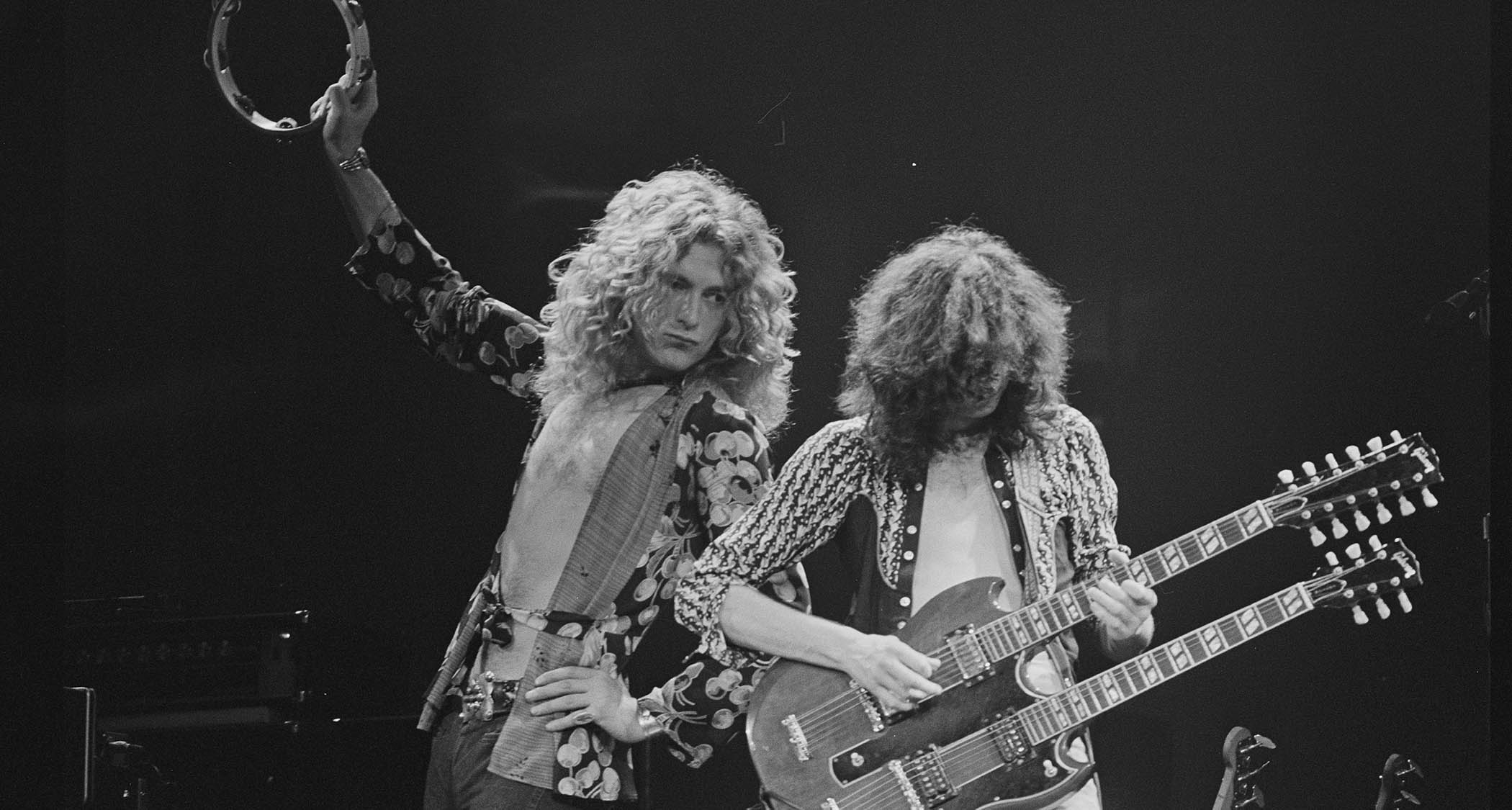
Jimmy Page’s legacy as one of the most influential players ever to wield an electric guitar has been well-documented over the years and undoubtedly seats him in a class of his own. But Page was equally as magnificent with an acoustic in his hands – as illustrated throughout his career with Led Zeppelin in songs such as Black Mountain Side, Bron-Yr-Aur, Black Country Woman, Babe I’m Gonna Leave You, The Rain Song, Poor Tom, Going To California, Thank You and, of course, the epic piece that has now been voted the greatest acoustic guitar song of them all (despite its many electric moments): Stairway To Heaven.
It all begins with an arpeggiated idea around the 5th and 7th frets which gradually moves down into open position as the bass note descends one fret at a time, performed on Page’s storied Sovereign H1260 (serial number 9631111260).
This guitar had proven to be a fundamental writing tool from Led Zeppelin’s early days and onwards, inspiring some of their best-known works, including songs that Page would later choose to record with an electric in the studio.
The idea itself is in various shades of A minor – thanks to the chromatically descending bass note which walks through scales such as harmonic minor, Dorian and natural minor one bar at a time.
There’s also a second half to the motif that picks through simple chords for C, D, Fmaj7 and Am, before returning back to the beginning as Robert Plant sings that unforgettable opening line: “There’s a lady who’s sure all that glitters is gold.” The only notable deviation comes at the end of this section, where Page picks his way through the same shapes in double time to tee up the next section of the song, which arrives roughly one quarter of the way in.
I wanted to try to put something together which started with quite a fragile, exposed acoustic guitar playing in the style of a poor man’s Bourrée by Bach
Jimmy Page
In a 2014 interview with BBC News, Page explained how he wanted the song to build in ways that would thrill listeners through its sense of meticulous ambition, taking them on a cinematic journey that would evolve in the most inventive and profound ways one step at a time.
“I wanted to try to put something together which started with quite a fragile, exposed acoustic guitar playing in the style of a poor man’s Bourrée by Bach,” he noted. “The idea was to have a piece of music, a composition, whereby it would just keep on unfolding into more layers, more moods. The subtlety of the intensity and the overlay of the composition would actually accelerate as it went through on every level, every emotional level, every musical level, so it just keeps opening up as it continues through its passage.”
As well as reflecting on how “all of this stuff was planned, it wasn’t just an accident or everyone chipping in, it really was a sort of design”, he also explained how broadening the band’s musical horizons involved breaking a few rules and thinking outside of the box, almost more like an orchestrator than a rock guitarist.
It’s this kind of stylistic open-mindedness that made him one of the most admired players of all-time, virtually peerless in terms of how he innovated with the instrument in his hands, someone whose influence would end up stretching far beyond that of your typical rock ’n’ roll player.
I was keen to do something which had an acceleration to it... Not only from the musical point of view, but for the lyricist, so the whole thing would gain momentum
Jimmy Page
“One of the cardinal rules when I was a session musician was that you didn’t speed up, and I was keen to do something which had an acceleration to it,” Page said.
“Not only from the musical point of view, but for the lyricist, so the whole thing would gain momentum as it went through, and it wasn’t just a monotone piece. And by that I actually mean it would subtly speed up, breaking that number one cardinal rule.”
The next section is where his 1965 Fender XII and Vox Phantom XII electric 12-strings get introduced, panned left and right to add more depth and shimmer to the same chords being performed on the Sovereign acoustic – including some interesting voicings for Em/D, D and C/D thanks to that open fourth string.
This is also the point of the song where Page would switch from the regular neck to the 12-string on the Gibson EDS-1275 he used for its live performances – reverting back just before the end for its legendary long-form guitar solo.
“When I recorded the song I wasn’t thinking about how I was going to do it live,” he told Total Guitar back in 2020. “With the sort of fragile guitar of the opening style and the more racy sort of pickups for the solo – the doubleneck is the only way I’m going to do it. So, in actual fact, the song demanded the guitar. There was no other way to replicate it, apart from jumping from one guitar to another on stage! That was about as good as it was going to get, really.”
The signature anthem’s final section is made up of three simple chords: Am, Am/G and Fmaj7, which outline the A natural minor scale and gives the song its melancholic feel. As a soloist, Page occasionally targets this mode – the relative minor to C major – by using intervals like the second and minor 6th (which in the key of A minor are the notes B and F), though the vast majority of the fretwork was composed using minor pentatonic ideas for more of a bluesy feel, played on the 1959 Telecaster given to him by fellow Yardbird Jeff Beck.
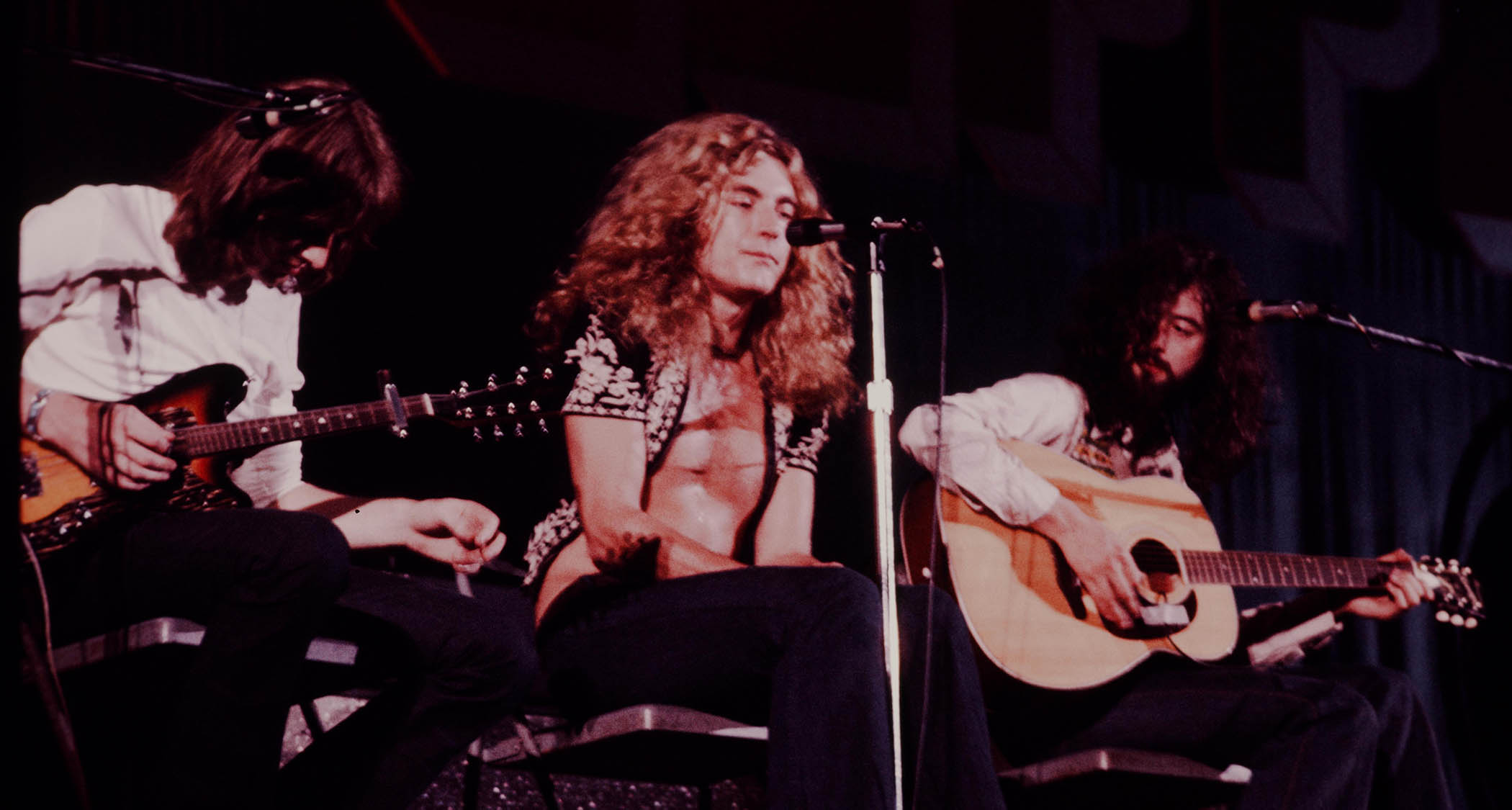
“I basically got my Telecaster out to do that solo,” Page told Classic Rock in 2021. “Even though I’d been playing Les Pauls, I wanted to get that bite of the Telecaster on it. It was the same Telecaster that I’d played on the first album, the one Jeff Beck had given me that I’d used in The Yardbirds. A bit of a magical guitar, really.”
And as for the rhythms underneath all those bends and trills, it’s what Page plays in between the chords – those all-important dead 16th notes where everything is muted and nothing is fretted – that gives the closing segment its sense of motion and swagger.
We were living in Headley Grange as a residence – eating, sleeping, making music. Stairway To Heaven is a by-product of all that
Jimmy Page
Though these rhythmic figures aren’t contributing anything melodically, the song wouldn’t sound quite the same without them. Similar things could be said of the “fanfare” that introduces the solo, Page letting the listener know something special is about to happen by the inclusion of some exaggerated strums going from Dsus2 to D and Dsus4.
“It’s a definite transition, with a fanfare to introduce the solo which will then soar right through,” he said in that BBC interview, while also reflecting on what an inspiration time it was for the four musicians.
“We were living in Headley Grange as a residence – eating, sleeping, making music. Stairway To Heaven is a by-product of all that and obviously quite substantial as a milestone for Led Zeppelin.”
